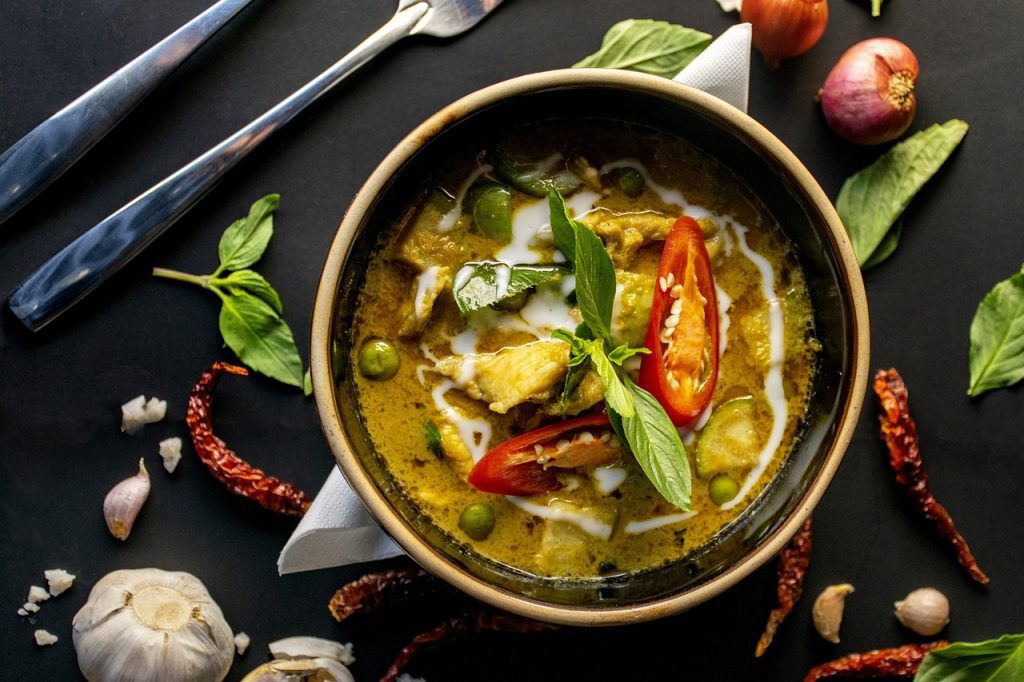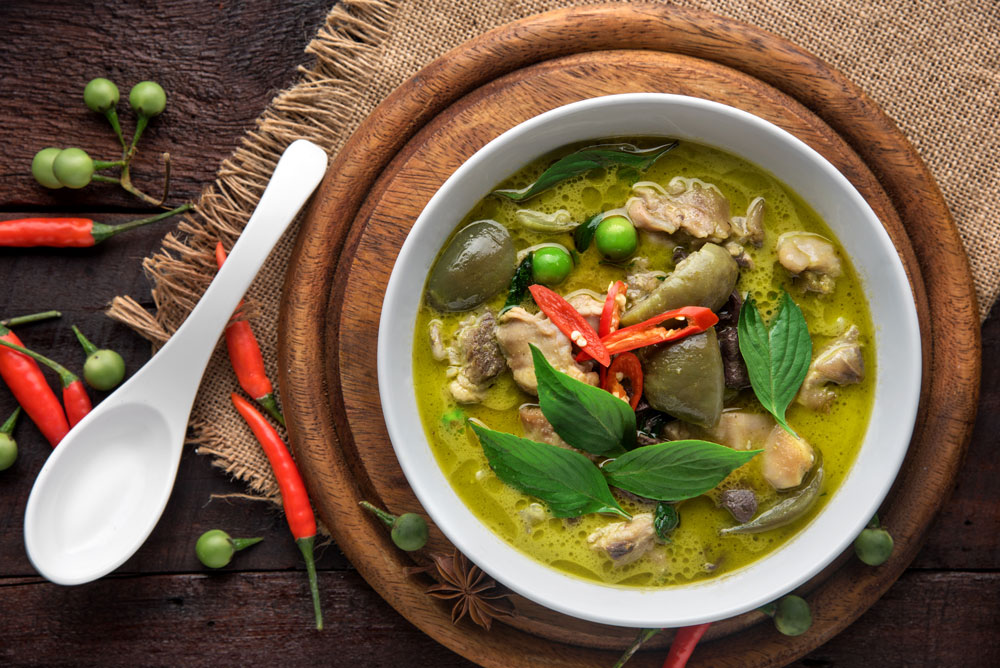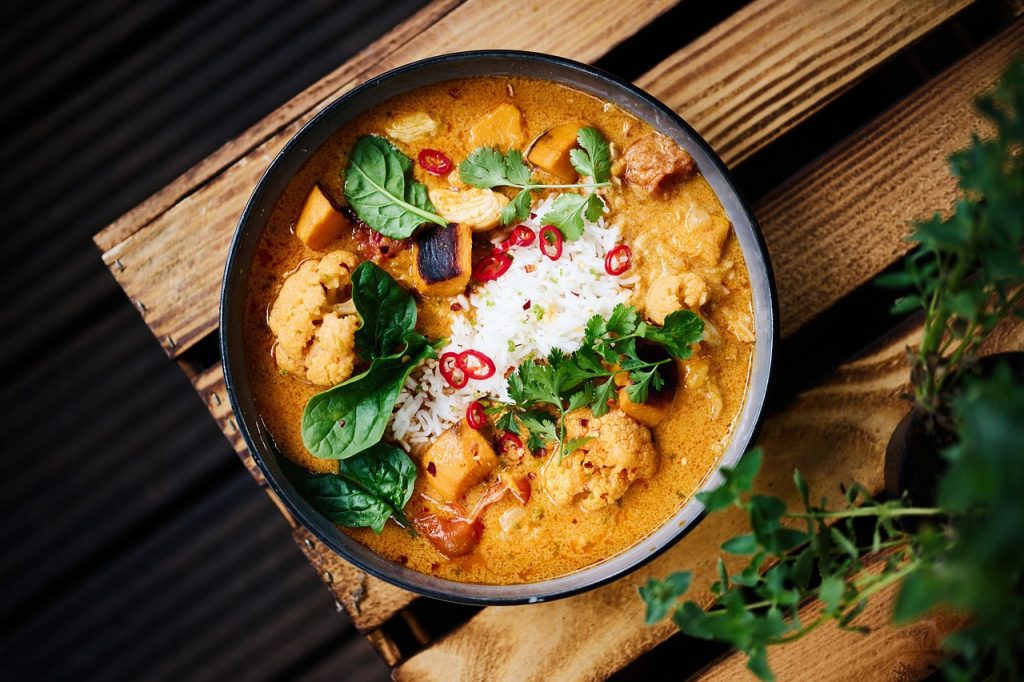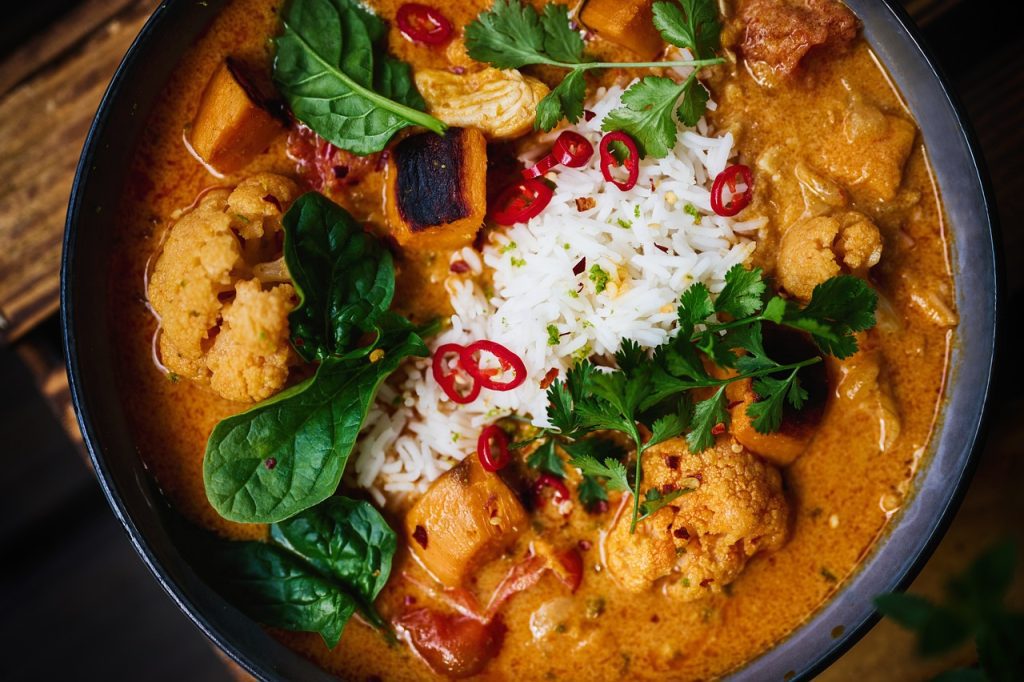Learn about Popular Types of Thai Curry. Delight in a Thai Curry Rice Bowl rich, aromatic curry with fragrant rice and fresh ingredients. Discover the most popular types of Thai curry, including red, green, yellow, Massaman, and Panang, each with unique flavors.
Introduction
The reputation of Thai food is built upon its colorful flavor, and scent and finding just the right blend of sweetness, acidity, saltiness, and spiciness. One recipe that successfully encompasses this cultural cuisine is the Thai Curry Rice Bowl. The dish stands for more than simply food; instead, this holiday of Thai curry flavors meets hearty rice bowl comfort. Whether as a connoisseur o fin-eater or a fresh person concerning Thai kitchen, Thai Curry Rice Bowl will address your palate with enjoyment and attract you to come back for it again.
Thai Curry Rice Bowl
Thai curry rice bowls undoubtedly capture the essence of Thai food by blending different tastes and experiences into a single dish. We generally have a heap of jasmine-scented rice with spicy Thai curried meat on top of its core.

The curry sauce, which may be red, green, yellow, or any other kind, consists of a mixture of herbs and spices along with coconut milk giving it creaminess and taste. Usually added are proteins such as chicken, beef, shrimp, or tofu, and also some vegetables that include bell peppers, eggplant, and bamboo shoots. Having fresh herbs and a squeeze of lime on top, Thai Curry Rice Bowls provide an enjoyable, eye-catching dish that feels so good and is foreign at the same time.
Popular Types of Thai Curry
Thai food is well known for its wide range and taste-enhancing curries, where each comes with its flavor and components. Some of the most favored varieties include:
1. Red Curry (Gaeng Daeng)
In this famous Thai recipe, the universe conspires to present a hot reddish dish with marvelous flavor – red curry. It comprises joining forces with red chilies garlic lemongrass and other spices to blend their forces in the creamy embrace of coconut milk. Commonly, red curries go with kinds of poultry, beef, and/or tofu combined with certain veggies such as bamboo shoots and bell peppers.
2. Green Curry (Gaeng Keow Wan)
The spiciest type of curry prepared in Thailand is Thai green curry, which stands out with its bright color and strong, refreshing flavor. However, it is composed of green chilies, Thai basil, coconut milk, and Kaffir lime leaves.
Curries are usually served with typical foods such as chicken, shrimp, or tofu along with vegetables like eggplants, peas, and green beans. The reason for its popularity stems from the flavor, which is rich, somewhat sweet, and hot.

3. Yellow Curry (Gaeng Karee)
Turmeric is used as a base for yellow curry giving it a milder flavor and sweetness which results in a warm golden color when compared to red or green curries. It is made by blending the turmeric with coconut milk and other spices like cumin, coriander, and ginger.
Curry in the yellow variety often comes with chicken, potatoes, and carrots. For those who dislike hot food, this is a great option as it has little spiciness.
4. Massaman Curry
Massalaman kari, a unique mixture of Thai and Indian influences, is known for its slightly sweet, tangy, and nutty flavor. Ingredients such as cinnamon, star anise, cardamom, and peanuts together with coconut milk from its recipes.
Massaman curry is traditionally made with beef, potatoes, and peanuts. It’s a dish that is very rich, chunky, strong tasting and it is mild too which makes it famous in the southern part of Thailand.
5. Panang Curry
A type of thick, delicious coconut milk curry made from panang curry paste that contains dried chilies, lemongrass, fresh lime rind, and salted peanuts is what Panang curry represents.
Beef or chicken are the usual accompaniments of panang curry, which often contain bell pepper and basil typically used in Thai cuisine. Given its creamy texture and low heat, people who prefer milder curries often favor it.
Impact of Thai Curry Rice Bowl on our environment
1. Ingredient Sourcing
Coconut milk, rice, herbs, and spices are among the ingredients commonly used in Thai Curry Rice Bowls that come from many tropical areas. Cultivated lands are implicated in these large-scale farming activities which mostly involve one crop only causing soil deterioration, loss of various living forms in this region, and cutting down trees at alarming rates.
One of the examples could be that growing these types of trees to produce coconuts for their juice can lead to them being cut down unsustainably.
2. Food Miles and Carbon Footprint
Several ingredients, most of which are not found in many places around the globe, are included in the formulation of Thai Curry Rice Bowls. This means that they have to be shipped from faraway places such as Thailand and other warm regions.
This transportation increases the carbon footprint of the dish, adding up to greenhouse gas emissions. The more an ingredient travels distance-wise, the greater its negative effect on the environment.
3. Packaging and Waste
As Thai Curry Rice Bowls get more famous in take-out and delivery formats, packaging shedding waste leads to environmental problems. If single-use plastic containers, cutlery, as well as bags are not properly thrown off or are not recycled, they encourage pollution.
The consequence of plastic garbage is notable as it frequently leads to pollution of both landfills and oceans and consequently hurts biodiversity.

4. Sustainable Alternatives
To reduce the environmental impact of Thai Curry Rice Bowls some consumers can make more sustainable decisions by using sustainable products. For example, choosing ingredients from a local farm can reduce food mileage and also protect local farmers.
By choosing organic or sustainably grown rice, coconut milk, and vegetables it is possible to reduce some negative impacts of extensive agriculture.
Furthermore, cooking at home or helping restaurants with eco-friendly takeaway containers may decrease the ecological footprint of this plate due to the less packaging waste generated.
5. Cultural and Economic Impact
On the positive side, the worldwide fame of Thai Curry Rice Bowls can positively affect the economy of Thailand as well as other countries supplying these components.
Supporting local farmers helps to enhance cultural exchanges while also educating more people about how they should engage in sustainable agricultural methods.
FAQs
Can I make Thai Curry Rice Bowls vegetarian or vegan?
Sure! Tofu may be used or some vegetables can be taken as the primary source of protein and for a non-meat dish, replace fish sauce with soy sauce or tamari.
Can I make Thai curry ahead of time?
Sure, Thai curry can be made earlier and kept in the fridge for three days. Reheat it and serve over freshly cooked rice when you want to eat.
What type of rice is best for Thai Curry Rice Bowls?
The best-known one is jasmine rice because of its nice smell and soft feel, while brown rice or sticky rice can be used too.
Conclusion
Thai Curry Rice Bowl is a wonderful example of how diverse and rich Thai food can be. It’s satisfying and healthy because it has fragrant rice, delicious curry, fresh ingredients, and carefully chosen toppings. Thai Curry Rice Bowl is not just another dish but can be made using an old-fashioned method or very differently assuming people don’t mind changing their tastes all the time and they make this type of food more diverse. Thus, go ahead! I recommend that whenever you feel like having something warm and unusual at once then try this Thai Curry Rice Bowl; it will never disappoint
